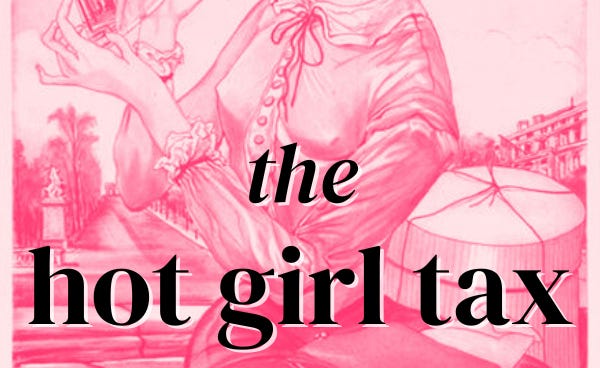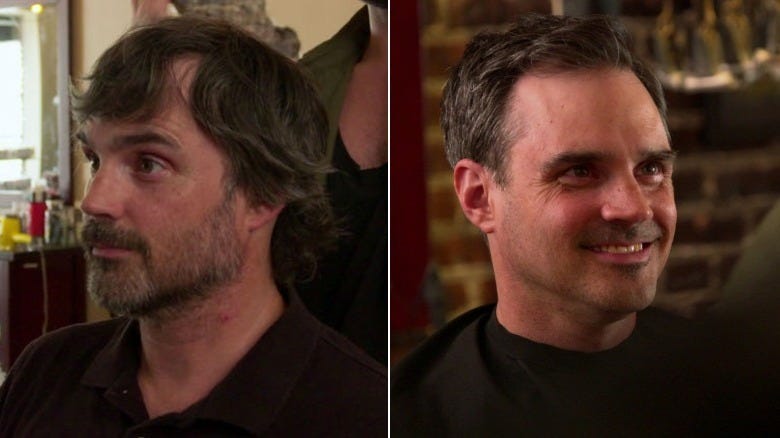I Can’t Retire, but at Least I Was Hot in My 20s
The ‘Hot Girl Tax’ that is screwing over women’s financial futures (we did the math)
Remember: keep your hair glossy and smooth. At least… until it’s meant to be textured with sculpted frizz.
And blend your foundation for that airbrushed skin look, but never overdo your makeup – you can’t look like you’re trying too hard, you know?
Unless, of course, you’re going glam… then if you don’t try hard enough you’ll just look ridiculous.
And don’t forget: Lips should be full. Lashes long. Body toned, but not too muscular.
If you’re confused, buy yourself a color analysis, a personal trainer, maybe a stylist and makeup artist. Come on, it’s an investment in yourself. Right?
Yeah, no. Today for The Pop Finance Report, we’re talking about the hot girl economy—aka the never-ending pursuit of maintaining ‘effortless beauty’ and how much we really pay for it. And spoiler: We really pay for it.
Insecurity is Profitable
It feels like from the first teen magazine to every social media scroll and rom-com, a single, resounding message is drilled into women: your looks define your worth.
And thus, it's good – no, noble – to pursue beauty. And like any noble cause, it deserves sacrifice and investment. “Beauty is pain” as they say.
And while we tend to think of physical pain, like squeezing ourselves into modern day corsets (Spanx!) or ripping follicles straight out of their biologically designated area (a Brazilian!), what we don’t often consider is financial pain.
In other words, how much money we are spending to chase a forever moving target!
But that’s the game, isn’t it? The beauty industry exists to sell us solutions to problems it often creates. Insecurity is profitable. The beauty industry manufactures new ‘imperfections’ for us to fix, from laugh lines to ‘strawberry legs.’
The diet industry convinces us that thin is the goal—until curves are back in style. Fitness once meant being strong, but now it’s about fitting an aesthetic: ‘toned but not bulky,’ ‘feminine but fit.’ The second we catch up, the rules change.
The message?
You’re almost there. Almost perfect. Almost enough.
So we keep chasing. And… we keep spending.
The catch: Women are treated differently based on looks.
Here’s the problem: these pressures aren’t imagined. Research shows that conventionally attractive women earn more than their “less-attractive” peers, a phenomenon often referred to as the "beauty premium."
Studies have found that attractive people are perceived as more competent, more likable, and even more trustworthy in the workplace, leading to higher salaries, more promotions, and greater career opportunities.
A report from the University of Texas found that “good-looking” workers earn about 10-15% more than those considered below average in attractiveness.1
And yes, “good-looking” applies to both men and women here. Men absolutely have their own set of beauty standards and unique pressures (I’m looking at you, Brad Pitt’s character in Fight Club).
But if we’re honest with ourselves, we know the bars for what makes a “good-looking” man vs “good-looking” woman are very different. There’s a reason the show Queer Eye’s ‘makeovers’ for men usually just involve buying clothes that aren’t stained and then getting a haircut.
Other studies indicate that women who conform to beauty standards—whether through professional grooming, cosmetics, or even cosmetic surgery—often have an economic advantage over those who do not. In certain industries, such as media, sales, and customer-facing roles, appearance can directly impact hiring decisions.
This is where things get complicated. Every time a woman opts into these beauty standards, whether by choice or necessity, it reinforces them—making it even harder for the next woman to opt out. When enough people play the game, not playing comes with a penalty.
The cost of beauty isn’t just personal—it’s systemic.
“Instead of accumulating wealth, we’re accumulating half-used skincare bottles and expired palettes.”
This creates an economic trap: Women are told that beauty is an investment, one that will pay off in social capital, career success, and thus potentially more money.
But the return on this investment is never guaranteed—and even when it exists, it comes with the constant financial burden of upkeep. So how much does it all cost?
The Real Cost of Keeping Up with Beauty Standards
We did the math, and oof. Here’s what we found:
Women spend an average of $3,756 per year on beauty products and services every year. That’s $313 a month. $10 a day.2
And where does it go?
Hair: Highlights, cuts, styling products, treatments
Skin: Serums, peels, facials, retinol
Makeup: Foundation, blush, bronzer, lip oil
Lashes & Brows: Extensions, lifts, tints, microblading
Body: Waxing, laser hair removal, anti-aging creams
Injectables: Botox, filler, preventative tweaks
If that money were invested instead, earning a 10% annual return from age 25 to 65, it would grow to $1,662,377.
And honestly, that's a conservative estimate, because beauty pressures and spending often begin well before age 25, especially with social media's growing influence targeting younger and younger demographics. (Have you seen the videos of tween girls’ Christmas lists these days? That’s a cool $500 right there ).
That money, over a million and a half dollars, isn’t just money —it’s financial freedom.
But instead of compounding interest, we’re compounding expenses.
So yeah, we might be hot in our 20s while pouring money into endless beauty regimens, but we are royally screwing over our future selves in the process.
Instead of accumulating wealth, we’re accumulating half-used skincare bottles and expired palettes.
Don’t get me wrong: This isn’t to say you should never spend on beauty, nor that it’s bad to want to look “good” according to society. Like the research shows, looking “good” can be a useful tool in the game of money, career, and connection.
But! We have to know when enough is enough. We have to stop blindly swiping our cards and start spending with intention.
💄 Ask yourself: Do I actually love this, or do I just feel like I "should" buy it?
Are you repurchasing that $80 serum because it actually works for you, or because a TikTok influencer with a beauty filter told you it’s life-changing?
💰 Create a “Beauty Budget” Like Any Other Expense
Think of beauty like rent, groceries, or travel—it deserves a line in your budget. Calculate how much you’re actually spending on beauty per year (not just per Sephora trip), then set aside a realistic amount each month. This keeps your spending intentional instead of reactive.
📈 Invest First, Glam Second
Before splurging on products, make sure your future self is getting a cut. Your 401(k), IRA, or brokerage account should be thriving before your makeup drawer is overflowing.
🚫 Break Free from Trend Chasing
Beauty brands need you to feel like you’re missing out. Remember: They profit off your insecurity. They will always push new “must-have” products to keep you in a cycle of spending. The smartest move? Stick to what actually works for you instead of getting sucked into the hype.
At the end of the day, beauty fades. We all stop being “hot”. The question is: will you still have power, choices, and financial security when that happens?
1 Hamermesh, D. S. (2011). Beauty pays: Why attractive people are more successful. Princeton University Press.
2 Washington State Department of Corrections. (2018). The price of beauty (Infographic No. 100-PO031). Washington State Department of Corrections.https://www.doc.wa.gov/docs/publications/infographics/100-PO031.htm









